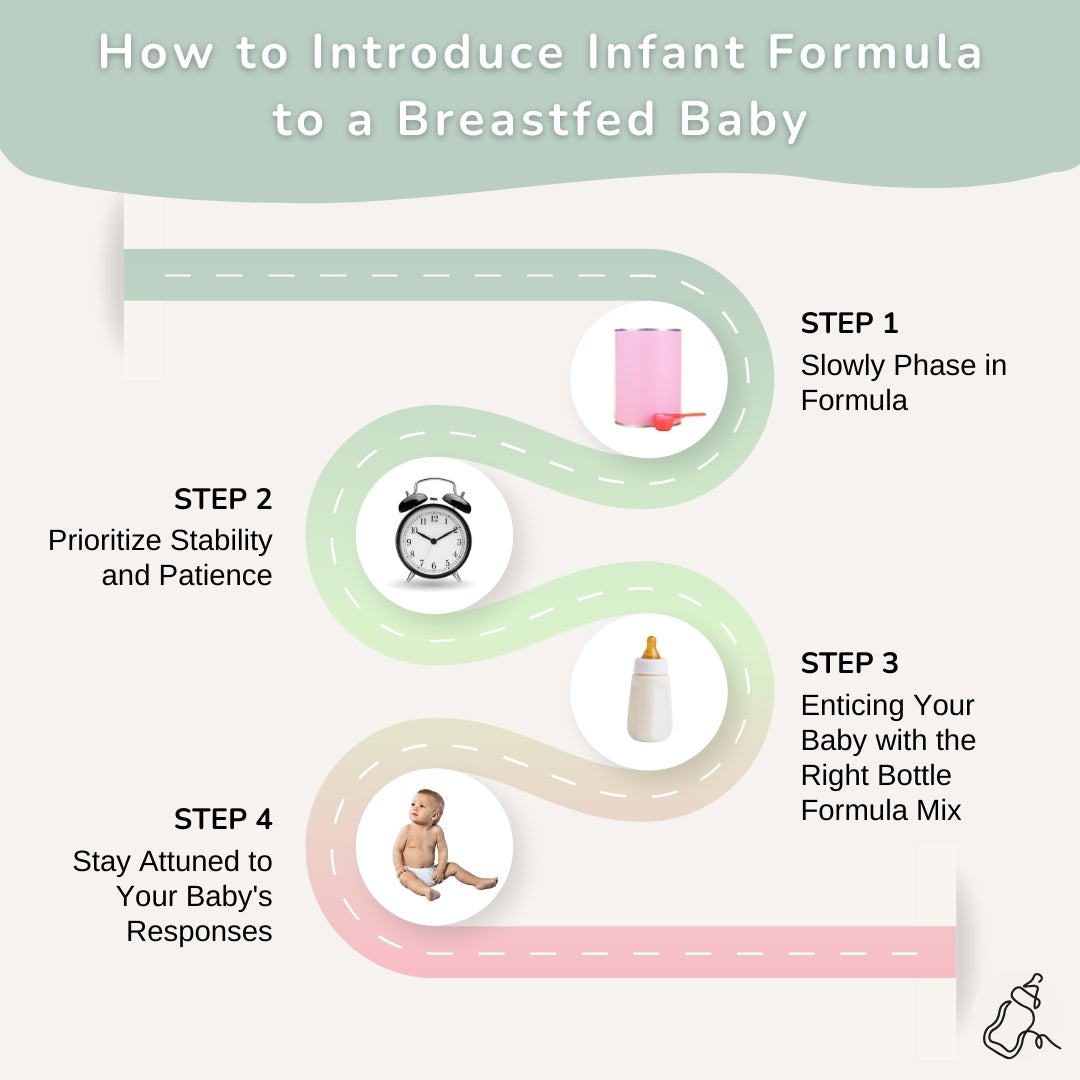There are countless reasons why parents switch from breast milk to formula.
Some want a more flexible schedule, others have to return to work and can't keep breastfeeding their little ones, some new moms struggle with a low milk supply, and some want their partners to participate in feedings.
Whatever the reason is, it is crucial to ensure a smooth transition to supplementing with formula for your little one. Change is always stressful, but armed with the right information on how to make the switch, combination feeding doesn't have to affect your baby negatively.
So set aside your worries because we've got you covered! In today's guide, we will share tips on how to introduce formula to a breastfed baby. So, keep on reading if you're ready to switch to bottle feeding!
Contents
- How to Introduce Formula to Your Breastfed Baby
- Preparing for the Transition: Choosing the Right Baby Formula
- How to Introduce Infant Formula to a Breastfed Baby: Step-by-Step Guide
- Tips for Supporting Your Baby During the Transition from Breast Milk to Infant Formula
- Frequently Asked Questions About Introducing Formula to Breastfed Babies
- Wrapping Up: How to Introduce Formula to a Breastfed Baby
How to Introduce Formula to Your Breastfed Baby
The American Academy of Pediatrics (AAP) recommends exclusively breastfeeding your baby until they turn at least 6 months old and breastfeeding for as long as possible because breast milk is the optimal source of nutrition for your little one.
However, if you cannot or choose not to breastfeed exclusively, formula feeding offers a viable alternative!
So, for those of you with breastfed babies looking to switch to formula bottles, here are some tips for making the transition as smooth as possible:
 1) Start with smaller amounts of baby formula and increase your child's intake gradually. To make things even more easy for them, you might want to mix breast milk and formula in the same bottle. This will help the baby get used to the formula's texture and taste faster.
1) Start with smaller amounts of baby formula and increase your child's intake gradually. To make things even more easy for them, you might want to mix breast milk and formula in the same bottle. This will help the baby get used to the formula's texture and taste faster.
It's worth mentioning that most medical experts agree a gradual transition is also better for the mother. If you introduce infant formula little by little, your body will have enough time to reduce its milk supply. This means fewer chances of experiencing pain, swollen breasts, or even mastitis.
2) Help your baby get a feel for drinking from a bottle. Start by pumping your breast milk and offering it to your baby in a bottle once in a while. And after your little one gets used to a different sucking action, you can combine breast milk with formula in the same bottle to ensure a trouble-free transition.
Preparing for the Transition: Choosing the Right Baby Formula
Before adding formula to your baby's diet, you need to do your research and prepare beforehand. This means figuring out which formula milk to use.
With such an impressive variety of baby formula types on the market, it's easy to get overwhelmed with all the options. That's why it's best to choose your child's supplemental formula by taking into account these 3 main factors:

1) Does your baby have any allergies?
Most often, for healthy babies, doctors recommend a cow's milk-based formula.
However, if your little one does have allergies, they may need a special formula in place of a standard cow's milk formula.
Keep in mind that the number of options at your disposal will narrow down as there are fewer hypoallergenic formulas or lactose-free variations than regular infant formulas.
But don't fret too much; your pediatrician will be able to guide you in selecting the right formula to supplement with based on your baby's unique needs.
2) Which type is the most convenient for you?
Beyond catering to your little one's dietary requirements, you should consider what type of formula works best for your lifestyle.
There are powdered, liquid concentrate, and ready-to-feed formulas, and each comes with its own pros and cons.
Formula Powder
Powder is the most affordable and offers the best value for money (as it lasts longer). At the same time, it's more challenging to prepare. Powder can be messy to handle, especially if you're in a hurry. Plus, it's easier to prepare incorrectly if you don't follow the instructions precisely.
Liquid Concentrate and Ready-to-Feed Formulas
With liquid concentrate formula, you still have to measure and mix the formula with water, but it tends to involve less mess than formula powder.
As for ready-to-feed infant formulas, they come premixed, so you don't need to stress about preparation errors! This is especially handy when travelling or when you're short on time.
3) How much of your budget can you allocate toward baby formula?
Liquid formulas offer greater convenience but at a greater cost, which is why most parents rely mainly on powdered formula for their babies.
As for parents with a particular interest in clean nutrition, choosing an organic formula may be a good choice. Our European organic formulas are a popular choice due to their simple ingredients list, high organic standards, and GMO-free recipes. You can explore our selection here.
Talking to a Doctor for Guidance
You should always consult a medical professional before introducing any changes to your baby's diet. A pediatrician can assess your baby's needs, help determine any allergies or intolerances they might have, and suggest the best course of action when transitioning to supplemental feeding.
A doctor can also recommend trustworthy formula brands and the most suitable formula type for your little one.
And remember: it's okay to ask for help. Parenting is hard for everyone (no matter what someone might say), so don't hesitate to ask as many questions as you want.
We are sure your doctor will answer them gladly, as they want to ensure your baby's safety and comfort just as much as you do!
How to Introduce Infant Formula to a Breastfed Baby: Step-by-Step Guide
Supplementing with formula requires careful consideration and planning beyond knowing which formula to choose.
So, let's take a look at the most important steps that can help you combine formula milk with your breastfeeding routine effectively:

1. Transitioning with Care: Slowly Phase in Formula
Transitioning from breastfeeding to formula requires a gentle approach. Begin by replacing just one breastfeeding session daily with a formula bottle.
This gradual shift helps acclimatize your baby to the new taste and feeding method without causing a sudden disruption.
Based on expert recommendations, consider starting with the mid-afternoon feeding. This is typically a time when your baby is alert yet relaxed and thus might be more receptive to a new feeding experience.
By introducing formula during this period, you're optimizing the chances of a smoother transition, as your baby may be less attuned to the subtle differences between breast milk and formula.
Over time, as your little one gets more accustomed to the formula, you can consider introducing it in other feeding sessions as well.
2. Prioritize Stability and Patience
Transitioning to combination feeding is smoother when your family’s routine remains stable. Opt for a time without major disruptions or changes.
For example, if your baby is teething, the added discomfort might complicate the transition, adding stress for both you and your little one.
Remember, shifting to combination or exclusive formula feeding isn’t an overnight process. It might take several weeks, so patience is vital.
There will be times when your baby might resist the bottle. When this happens, stay persistent and don't get disheartened. As time progresses, the transition will become more manageable!
3. Enticing Your Baby with the Right Bottle Formula Mix
One effective way to help your baby adapt is by blending a little expressed breast milk with the formula. The familiar scent of breast milk can make the new feeding experience more appealing and reassuring.
Additionally, the bottle's nipple plays a pivotal role in your baby's acceptance. Every baby has preferences, so you might need to experiment with different bottle brands to find the one that feels most natural and comfortable for them.
Remember, the goal is to make the transition as seamless as possible, and that might mean sampling a few options before settling on the perfect fit.
4. Stay Attuned to Your Baby's Responses
Your child's reactions are the most valuable insights during this transition. If they seem uneasy with the formula's texture or appear uncomfortable with a particular bottle, it's a sign that adjustments are needed.
Pay keen attention to their cues and refine the transition strategy to make the experience as pleasant and stress-free as possible for both of you, and don't hesitate to ask for guidance from your baby's doctor along the way.
Tips for Supporting Your Baby During the Transition from Breast Milk to Infant Formula
Now that you know how to combine breast milk and formula, allow us to share some tips that can make the process gentler for you and your little one.
 • Try to maintain consistent feeding times. Babies need routine, and sticking to the same feeding hours can help your little one get used to supplementary formula faster.
• Try to maintain consistent feeding times. Babies need routine, and sticking to the same feeding hours can help your little one get used to supplementary formula faster.
• Ensure your baby is comfortable and relaxed during feedings. Find a comfy position, eliminate the distractions, and try maintaining some skin-to-skin contact as you would during breastfeeding sessions.
It's also helpful to switch sides as if giving your baby right and left breast alternatively. This helps you mimic breastfeeding and keep the baby blissfully unaware of the changes you're trying to introduce.
• Allow another caretaker to feed your baby. Oftentimes, when a little one refuses to take a bottle from their mother, they might accept it from someone else. This is because if mom smells like breast milk, it makes the bottle seem less enticing.
• Offer emotional support and reassurance throughout the process. Naturally, your baby should feel calm and safe regardless of the feeding type you choose. Thus, it's crucial to make them feel relaxed. You can hum a soft melody, pat your little one's back, or rock them slightly back and forth.
Frequently Asked Questions About Introducing Formula to Breastfed Babies
We hope you've learned a lot about how to introduce formula to breastfed babies. But in case you still have some lingering questions, here are some common queries parents have about supplementing breast milk with formula milk.
Can I switch between breastfeeding and formula feeding freely?
After your baby gets used to bottle feeding and supplemental formula, you can switch between breast milk and formula whenever you want.
How can I maintain my milk supply while introducing formula?
The best trick to maintain milk supply when introducing formula to breastfed babies is pumping. To help your body keep making milk, you should pump as many times (ideally) as your baby feeds.
You can store your expressed breast milk in the fridge or freezer for later use. The key is to mimic the act of breastfeeding to trick your body into thinking your baby still takes the breast regularly.
What should I do if my baby refuses to take a bottle or formula?
Make sure you offer a bottle when your baby is in a good mood. You can also try different positions or even have someone else feed the baby. It's also crucial not to force the bottle. It's better to take a short break and try again later.
If you continue to struggle to combine both breast milk and formula, reach out to a lactation consultant for expert advice and support.
Is it possible to return to exclusive breastfeeding after introducing formula?
Usually, it's possible to return to breastfeeding even after your child gets used to baby bottles and infant formula. However, you need to make sure you produce enough milk consistently and return to breastfeeding gradually.
So, if your plan is to offer combo feeding temporarily, make sure to take the necessary actions to preserve your breast milk supply.
Wrapping Up: How to Introduce Formula to a Breastfed Baby
Now, you know all the important steps and tricks to ensure your little one goes through this transition without experiencing much stress. Remember to talk to a medical professional to help make informed decisions.
And if you don't know which formula to start with, check out Baby Milk Bar! We offer a wide selection of popular formulas and the most reliable European brands. Our customer service team is happy to provide guidance to make sure your baby gets exactly what they need.
So, visit Baby Milk Bar today and explore our selection of premium formulas to find the perfect option for your baby's new routine of combination feeding!
Breast milk is the best source of nutrition for babies. Before altering your baby's diet or feeding routine, consult your healthcare provider for personalized recommendations. The information in this article is strictly for informational purposes and is not a substitute for medical advice.





